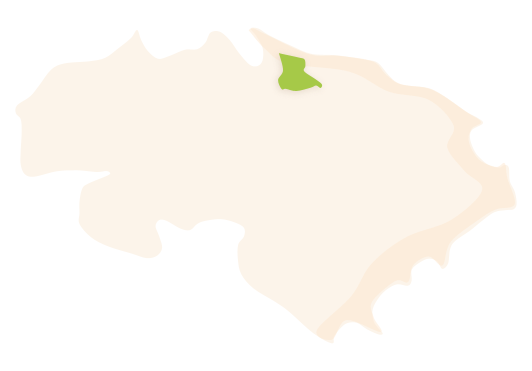El Verger is a municipality located in the northern part of the region, in the plain of the River Girona, in the lower part of the basin before it flows into the Mediterranean Sea. This small town is located 25 metres above sea level, in the shadow of the mountain known as Segària, between its eastern slope and the sea. It has a total area of 8.2 km² and 4,841 inhabitants, called Vergerins and Vergerines.
 El Verger's municipal district. Surface area: 8.2 km². Population: 4,841 (INE data 2021).
El Verger's municipal district. Surface area: 8.2 km². Population: 4,841 (INE data 2021).HISTORY
Coromines says that the origin of the town’s name comes from Latin, from the word Viridarivm, which means “orchard with a variety of flowers and fruit trees”.
The earliest signs of human occupation were discovered in the cave called Cova Fosca, which was used as a sanctuary and shelter from the Eneolithic period until the Islamic era. Other examples of these first settlements are the cave called Cova del Colom (from the Paleolithic) and the Bronze Age settlement located on La Penya Roja. However, the oldest piece of information available which refers to the modern town describes El Verger as a small town inhabited by Muslims and belonging to a prominent Arab from Dénia. The only remaining evidence of this Islamic hamlet is Torre de La Cremadella, a watchtower of Muslim origin situated in the area known as La Cremadella.
In February 1245, El Verger was conquered by the troops of Jaume I and given as a privilege to Pere Eiximén d’en Carròs, captain of Jaume I’s armies. Pere Eiximén let the Muslim inhabitants stay in the town and as a result they continued to live in this area for a few more centuries. After the decree issued by Carles V in 1525, they were forced to get baptised and to convert to Christianism, threatened with expulsion if they did not comply. From then on, they were called Moriscos or New Christians. On the 2nd of September 1609, Francisco de Rojas y Sandoval, Duke of Lerma, ordered their expulsion. At that time, El Verger had 80 houses and was under Ondara’s administrative control. After the expulsion, it was repopulated with people who came from Dénia, Pego and the Balearic Islands; in 1646, the surnames of Cardona, Costa d’Eivissa and Sendra de Pego were still widespread.
El Verger also stands out as a town because it is the only municipality in which a trapiche or sugar mill can still be found. It was used to transform the sugarcane that was cultivated in this area, mainly during the 15th and 16th centuries.
With the rise of the raisin industry, “riuraus” (a typical construction in the area used as a shelter for the raisins in case of bad weather) and vineyards could be found throughout the municipality. Although some remains of this period can still be seen, the phylloxera wreaked havoc and pushed El Verger to convert to irrigated farming, focused on citrus trees. One can see some testimonies of these times of prosperity in dwellings from the late 19th century and the beginning of the 20th century.
FESTIVITIES
- Saint Antoni del Porquet is celebrated in January with the traditional blessing of the animals.
- The festivities of Els Moros i Cristians (“Moors and Christians”) are celebrated on the day of Saint Roc, the 16th of August. Afterwards, the town’s patron saint festivities are celebrated, in honour of La Mare de Déu del Roser; these festivities, followed by the ones in honour of Saint Roc, Saint Isidre and the running of the bulls (“bous al carrer”) round up the summer festivities.
GASTRONOMY
- Paella with chickpeas: a type of paella deeply rooted in many towns of La Marina Alta and La Marina Baixa, even if it may seem a strange dish.
- Prawns with chard is one of the most typical dishes in the region. It contains river prawns and it is especially linked to the municipalities of El Baix Girona. The riverside towns and villages have other typical recipes such as “espardenyada”, made of eel and meat.
- ”Coques al forn”: baked flatbreads with all kinds of fillings, such as cold meats, vegetables, tomatoes or peas.